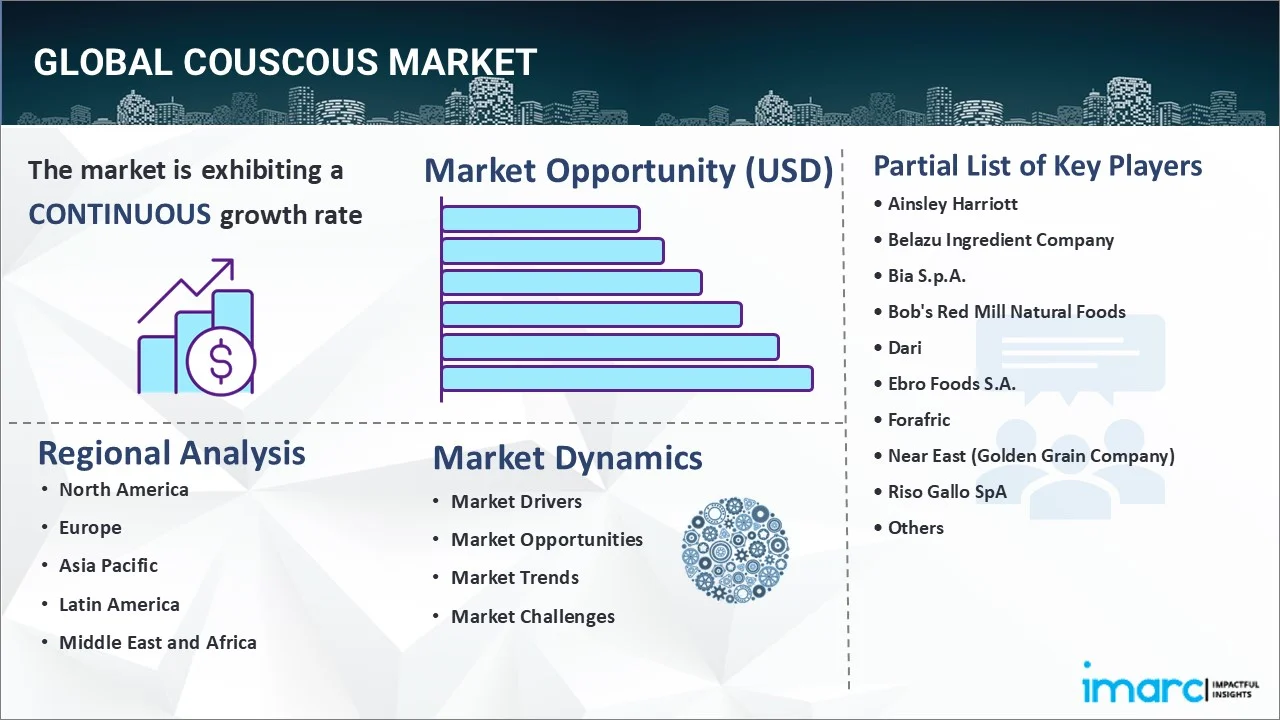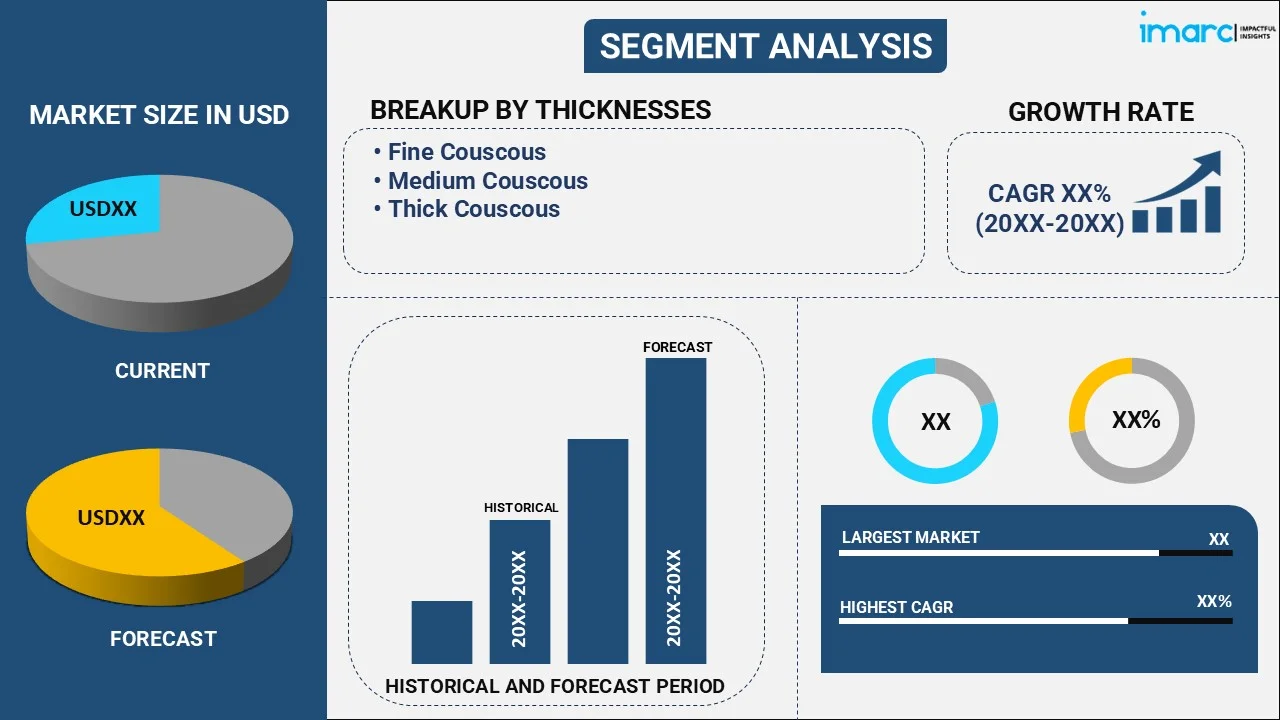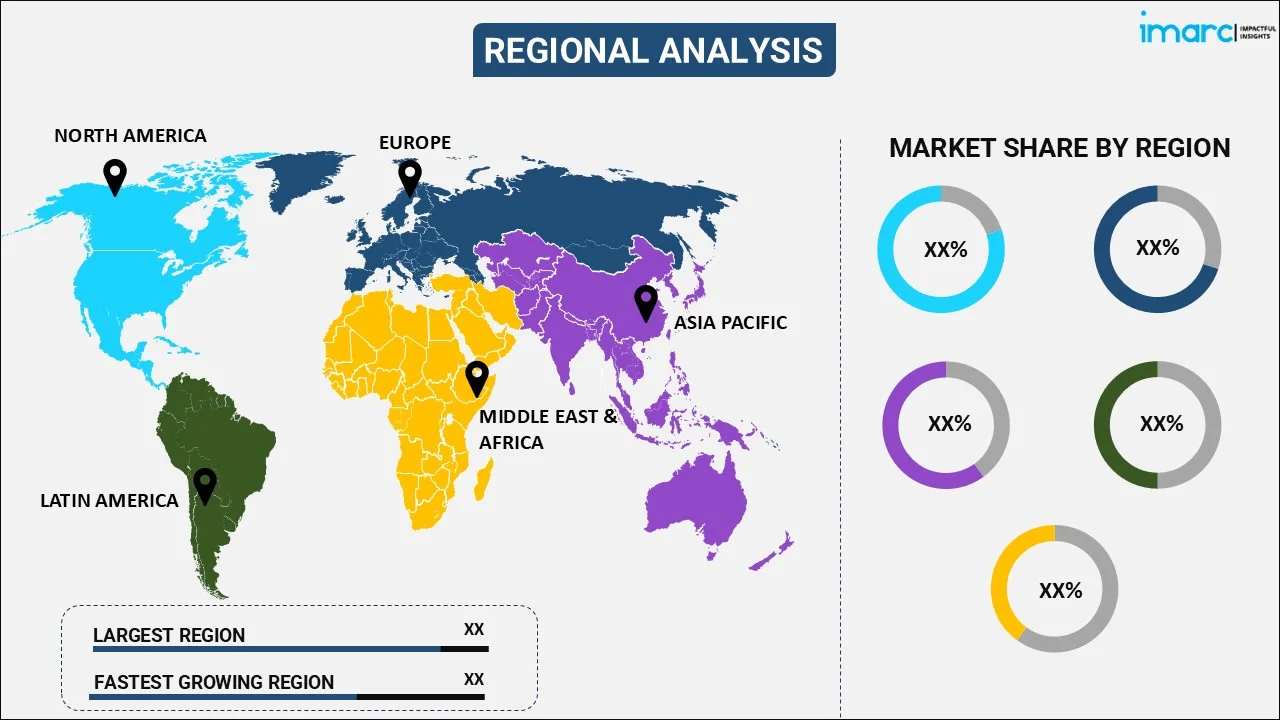
Couscous Market Report by Thickness (Fine Couscous, Medium Couscous, Thick Couscous), Distribution Channel (Supermarkets and Hypermarkets, Independent Retailers, Convenience Stores, Specialty Stores, Online, and Others), and Region 2025-2033
Couscous Market Size:
The global couscous market size reached USD 34.2 Billion in 2024. Looking forward, IMARC Group expects the market to reach USD 43.9 Billion by 2033, exhibiting a growth rate (CAGR) of 2.65% during 2025-2033. The market is experiencing stable growth driven by the growing consciousness among the masses about their diet choices, rising demand for convenient and time-saving meal solutions, and increasing consumption of plant-based diets due to health, ethical, and environmental reasons.
|
Report Attribute
|
Key Statistics
|
|---|---|
|
Base Year
|
2024
|
|
Forecast Years
|
2025-2033
|
|
Historical Years
|
2019-2024
|
|
Market Size in 2024
|
USD 34.2 Billion |
|
Market Forecast in 2033
|
USD 43.9 Billion |
| Market Growth Rate 2025-2033 | 2.65% |
Couscous Market Analysis:
- Market Growth and Size: The market is witnessing steady growth, driven by the increasing consumer interest in diverse and healthy food options. In addition, the rising awareness among the masses about Mediterranean and Middle Eastern cuisines is impelling the market growth.
- Technological Advancements: Technological innovations in couscous production, such as automated milling and packaging, are improving efficiency and quality control in the market.
- Industry Applications: Couscous is widely used in the foodservice industry, particularly in restaurants and catering. Besides this, the increasing popularity of couscous in households as a versatile and quick-cooking grain alternative is propelling the growth of the market.
- Geographical Trends: Europe leads the market, driven by the increasing popularity of Mediterranean and Middle Eastern cuisines. However, North America is emerging as a fast-growing market, driven by the increasing multicultural food trends and a rising interest in healthy eating.
- Competitive Landscape: The market is characterized by intense competition with several well-established players and new entrants. Companies often focus on product differentiation and sustainable sourcing to gain a competitive edge.
- Challenges and Opportunities: While the market faces challenges, such as price volatility of raw materials and competition from alternative grains, it also encounters opportunities in product innovation, expanding into new markets, and adopting sustainable practices.
- Future Outlook: The future of the couscous market looks promising, with the growing consumer interest in healthy and international cuisines, coupled with sustainable practices.

Couscous Market Trends:
Healthy eating trends
The shift towards healthier eating habits around the world is strengthening the growth of the market. Consumers are increasingly conscious of their diet choices and are seeking nutritious alternatives to traditional grains like rice and pasta. Couscous, often perceived as a healthier option due to its whole wheat and gluten-free variants. As health-consciousness is growing, couscous is seen as a versatile, low-calorie, and nutrient-rich choice. It is rich in fiber, protein, and essential minerals, making it a favorable option for those looking to maintain a balanced diet. This trend is particularly prominent in regions, where Mediterranean and Middle Eastern cuisines, featuring couscous, are gaining popularity. Furthermore, the increasing demand for traditional and innovative couscous products is bolstering the growth of the market.
Cultural diversity and globalization
The increasing cultural diversity and globalization of food trends worldwide is contributing to the market growth. As people are exploring international cuisines and adopt multicultural eating habits, couscous is gaining traction as a staple ingredient in Mediterranean, Middle Eastern, and North African cuisines. The appeal of couscous lies in its adaptability to various culinary styles and flavors. It can be used as a base for a wide range of dishes, ranging from salads and tagines to fusion recipes that blend diverse ingredients. This versatility aligns with the evolving tastes of consumers who seek novel and exotic food experiences. Furthermore, the rise of international travel and exposure to different cultures is making couscous a familiar and intriguing option for consumers worldwide. Besides this, the growing demand for authentic and innovative couscous products that cater to diverse tastes and preferences of individuals is offering a favorable market outlook.
Convenience and time-efficiency
The increasing demand for convenient and time-saving meal solutions is bolstering the market growth. Couscous is renowned for its quick and easy preparation, making it a popular choice for busy individuals and households. In a fast-paced world, consumers are often looking for hassle-free cooking options that require minimal effort and time. Couscous fits this requirement perfectly, as it can be cooked in a matter of minutes by simply adding hot water or broth. This attribute makes it a go-to choice for those seeking a nutritious and satisfying meal without the lengthy cooking times associated with many other grains. Additionally, foodservice establishments, such as restaurants and cafeterias, find couscous to be a practical and efficient ingredient for their menus.
Rising vegetarian and vegan lifestyle choices
The growing adoption of vegetarian and vegan lifestyles worldwide is positively influencing the market. As more people are embracing plant-based diets for health, ethical, and environmental reasons, couscous is becoming a valuable addition to their culinary repertoire. Couscous, particularly the whole wheat and gluten-free varieties, aligns well with vegetarian and vegan diets, offering a source of plant-based protein and fiber. It serves as an excellent base for vegetable-centric dishes, providing a satisfying and nutritious alternative to meat and dairy-based meals. The increasing popularity of vegetarian and vegan lifestyles is leading to a rise in demand for meatless meal options and plant-based proteins. Couscous manufacturers and foodservice providers are offering a variety of vegetarian and vegan-friendly couscous products and recipes, which is impelling the market growth.
Couscous Industry Segmentation:
IMARC Group provides an analysis of the key trends in each segment of the market, along with forecasts at the global, regional, and country levels for 2025-2033. Our report has categorized the market based on thickness and distribution channel.
Breakup by Thickness:

- Fine Couscous
- Medium Couscous
- Thick Couscous
Medium couscous accounts for the majority of the market share
The report has provided a detailed breakup and analysis of the market based on the thickness. This includes fine couscous, medium couscous, and thick couscous. According to the report, medium couscous represented the largest segment due to its versatility and widespread usage. These couscous grains strike a balance between quick cooking and retaining a pleasant texture. They are commonly featured in traditional couscous recipes like tagines and couscous-based main courses. This segment appeals to both home cooks and restaurants, contributing significantly to the overall market size.
Fine couscous, characterized by its small and delicate grains, caters to consumers seeking a quick-cooking option. This segment is popular due to its convenience and suitability for dishes like salads and side dishes. Fine couscous is often chosen for its ability to absorb flavors and dressings effectively, making it a versatile choice for culinary experimentation.
Thick couscous, characterized by larger grains, is the choice for dishes requiring a heartier and more substantial texture. It is often used in soups, stews, and as a base for dishes with rich sauces. While it constitutes a smaller segment of the market compared to fine and medium couscous, it caters to specific culinary preferences and is appreciated for its ability to enhance the consistency and mouthfeel of dishes.
Breakup by Distribution Channel:
- Supermarkets and Hypermarkets
- Independent Retailers
- Convenience Stores
- Specialty Stores
- Online
- Others
Supermarkets and hypermarkets hold the largest share in the industry
A detailed breakup and analysis of the market based on the distribution channel have also been provided in the report. This includes supermarkets and hypermarkets, independent retailers, convenience stores, specialty stores, online, and others. According to the report, supermarkets and hypermarkets accounted for the largest market share due to its extensive reach and convenience. Supermarkets and hypermarkets offer a wide variety of couscous brands and products under one roof, making it the preferred choice for many consumers. Shoppers often choose these stores for their regular grocery needs, allowing them to easily include couscous in their shopping baskets. The visibility and accessibility of couscous products in these outlets contribute significantly to their market share.
Independent retailers, including local grocery stores and neighborhood markets, play a role in catering to consumers seeking convenience and a personal touch. While their couscous product offerings may be more limited compared to larger chains, they serve specific communities and individuals who prefer shopping at smaller, local establishments.
Convenience stores stock couscous products to cater to on-the-go consumers looking for quick meal solutions. The convenience factor of these stores makes them suitable for impulse purchases or emergency grocery runs. While the couscous selection in convenience stores may be limited, they serve as an important distribution channel, especially in urban areas.
Specialty stores, such as international or gourmet food shops, focus on offering unique and high-quality couscous varieties. These stores attract consumers interested in exploring diverse couscous options and gourmet culinary experiences. While this segment represents a niche market, it caters to discerning consumers seeking premium couscous products.
The online segment is experiencing significant growth, driven by the convenience of e-commerce and the availability of a wide range of couscous products online. Consumers can browse, compare, and purchase couscous from the comfort of their homes, with home delivery options. This channel is particularly attractive to tech-savvy shoppers and those looking for specialty or organic couscous varieties.
Breakup by Region:

- North America
- United States
- Canada
- Europe
- Germany
- France
- United Kingdom
- Italy
- Spain
- Others
- Asia Pacific
- China
- Japan
- India
- South Korea
- Australia
- Indonesia
- Others
- Latin America
- Brazil
- Mexico
- Others
- Middle East and Africa
Europe leads the market, accounting for the largest couscous market share
The market research report has also provided a comprehensive analysis of all the major regional markets, which include North America (the United States and Canada); Europe (Germany, France, the United Kingdom, Italy, Spain, and others); Asia Pacific (China, Japan, India, South Korea, Australia, Indonesia, and others); Latin America (Brazil, Mexico, and others); and the Middle East and Africa. According to the report, Europe accounted for the largest market share due to the strong culinary influence of Mediterranean and North African cuisines in the region, where couscous is a staple ingredient. Countries like France, Italy, and Spain have incorporated couscous into their traditional dishes. Additionally, the health-conscious European population increasingly appreciates couscous for its nutritional value, further strengthening to the market growth.
The couscous market in North America has been experiencing growth, driven by the increasing multicultural food trends and a rising interest in healthy eating. Mediterranean and Middle Eastern cuisines featuring couscous are gaining popularity, especially in the United States and Canada. The convenience of couscous as a quick-cooking grain alternative is contributing to its adoption in North American households.
The couscous market in Asia Pacific is rising at a slower pace compared to other regions. As consumers in countries like Australia, Japan, and South Korea explore international cuisines, couscous is gaining recognition as a versatile ingredient. The health benefits and adaptability of couscous align with the growing interest in healthier eating habits in this region.
While couscous is not as deeply rooted in Latin American cuisine as in other regions, it is gradually gaining traction, particularly in countries like Brazil and Argentina. Consumers are becoming more open to incorporating couscous into their diets due to its convenience and versatility.
In the Middle East and Africa region, couscous remains a dietary staple. It is widely consumed in various forms across the region, particularly in North African countries like Morocco and Tunisia. While the market may be more mature in these areas, there is still a need for innovation and product diversification to cater to changing consumer preferences.
Leading Key Players in the Couscous Industry:
Key players in the market are actively engaged in several strategic initiatives to maintain their market positions and drive growth. These initiatives include product diversification and innovation, with an emphasis on introducing new couscous varieties, flavors, and packaging formats to cater to changing consumer preferences. Sustainability practices are also a focus, with many players adopting eco-friendly sourcing and production methods to appeal to environment conscious consumers. Additionally, they rely on marketing and promotional efforts to raise awareness about couscous as a versatile and healthy grain alternative, targeting both traditional and emerging markets. Collaborations with chefs and culinary influencers, along with expanding distribution networks, are part of their efforts to reach a wider consumer base and tap into the growing demand for couscous products.
The market research report has provided a comprehensive analysis of the competitive landscape. Detailed profiles of all major companies have also been provided. Some of the key players in the market include:
- Ainsley Harriott
- Belazu Ingredient Company
- Bia S.p.A.
- Bob's Red Mill Natural Foods
- Dari
- Ebro Foods S.A.
- Forafric
- Near East (Golden Grain Company)
- Riso Gallo SpA
- Roland Foods, LLC
- San Remo
- US Durum Products Ltd.
(Please note that this is only a partial list of the key players, and the complete list is provided in the report.)
Latest News:
- July, 2023: Forafric, a leading Moroccan grain trader and processor, has acquired 90% of Societe Industrielle de Minoterie du Sud (SIMS), a soft wheat milling company with primary operations in Marrakesh, to expand their crushing capacity of wheat rapidly by more than 300 tons per day with minimal capital investment.
Couscous Market Report Scope:
| Report Features | Details |
|---|---|
| Base Year of the Analysis | 2024 |
| Historical Period | 2019-2024 |
| Forecast Period | 2025-2033 |
| Units | Billion USD |
| Scope of the Report | Exploration of Historical Trends and Market Outlook, Industry Catalysts and Challenges, Segment-Wise Historical and Future Market Assessment:
|
| Thicknesses Covered | Fine Couscous, Medium Couscous, Thick Couscous |
| Distribution Channels Covered | Supermarkets and Hypermarkets, Independent Retailers, Convenience Stores, Specialty Stores, Online, Others |
| Regions Covered | Asia Pacific, Europe, North America, Latin America, Middle East and Africa |
| Countries Covered | United States, Canada, Germany, France, United Kingdom, Italy, Spain, China, Japan, India, South Korea, Australia, Indonesia, Brazil, Mexico |
| Companies Covered | Ainsley Harriott, Belazu Ingredient Company, Bia S.p.A., Bob's Red Mill Natural Foods, Dari, Ebro Foods S.A., Forafric, Near East (Golden Grain Company), Riso Gallo SpA, Roland Foods, LLC, San Remo, US Durum Products Ltd, etc. |
| Customization Scope | 10% Free Customization |
| Post-Sale Analyst Support | 10-12 Weeks |
| Delivery Format | PDF and Excel through Email (We can also provide the editable version of the report in PPT/Word format on special request) |
Key Benefits for Stakeholders:
- IMARC’s industry report offers a comprehensive quantitative analysis of various market segments, historical and current market trends, market forecasts, and dynamics of the couscous market from 2019-2033.
- The research report provides the latest information on the market drivers, challenges, and opportunities in the global couscous market.
- The study maps the leading, as well as the fastest-growing, regional markets. It further enables stakeholders to identify the key country-level markets within each region.
- Porter's five forces analysis assists stakeholders in assessing the impact of new entrants, competitive rivalry, supplier power, buyer power, and the threat of substitution. It helps stakeholders to analyze the level of competition within the couscous industry and its attractiveness.
- The competitive landscape allows stakeholders to understand their competitive environment and provides insight into the current positions of key players in the market.
Key Questions Answered in This Report
The global couscous market was valued at USD 34.2 Billion in 2024.
We expect the global couscous market to exhibit a CAGR of 2.65% during 2025-2033.
The rising demand for couscous, as it assists in strengthening muscles, boosting the immune system, repairing damaged tissues, etc., is primarily driving the global couscous market.
The sudden outbreak of the COVID-19 pandemic has led to the changing consumer inclination from conventional brick-and-mortar distribution channels towards online retail platforms for the purchase of couscous.
Based on the thickness, the global couscous market has been segregated into fine couscous, medium couscous, and thick couscous. Among these, medium couscous currently holds the largest market share.
Based on the distribution channel, the global couscous market can be bifurcated into supermarkets and hypermarkets, independent retailers, convenience stores, specialty stores, online, and others. Currently, supermarkets and hypermarkets exhibit a clear dominance in the market.
On a regional level, the market has been classified into North America, Asia Pacific, Europe, Latin America, and Middle East and Africa, where Europe currently dominates the global market.
Some of the major players in the global couscous market include Ainsley Harriott, Belazu Ingredient Company, Bia S.p.A., Bob's Red Mill Natural Foods, Dari, Ebro Foods S.A., Forafric, Near East (Golden Grain Company), Riso Gallo SpA, Roland Foods, LLC, San Remo, US Durum Products Ltd, etc.
Need more help?
- Speak to our experienced analysts for insights on the current market scenarios.
- Include additional segments and countries to customize the report as per your requirement.
- Gain an unparalleled competitive advantage in your domain by understanding how to utilize the report and positively impacting your operations and revenue.
- For further assistance, please connect with our analysts.
 Inquire Before Buying
Inquire Before Buying
 Speak to an Analyst
Speak to an Analyst
 Request Brochure
Request Brochure
 Request Customization
Request Customization




.webp)




.webp)












